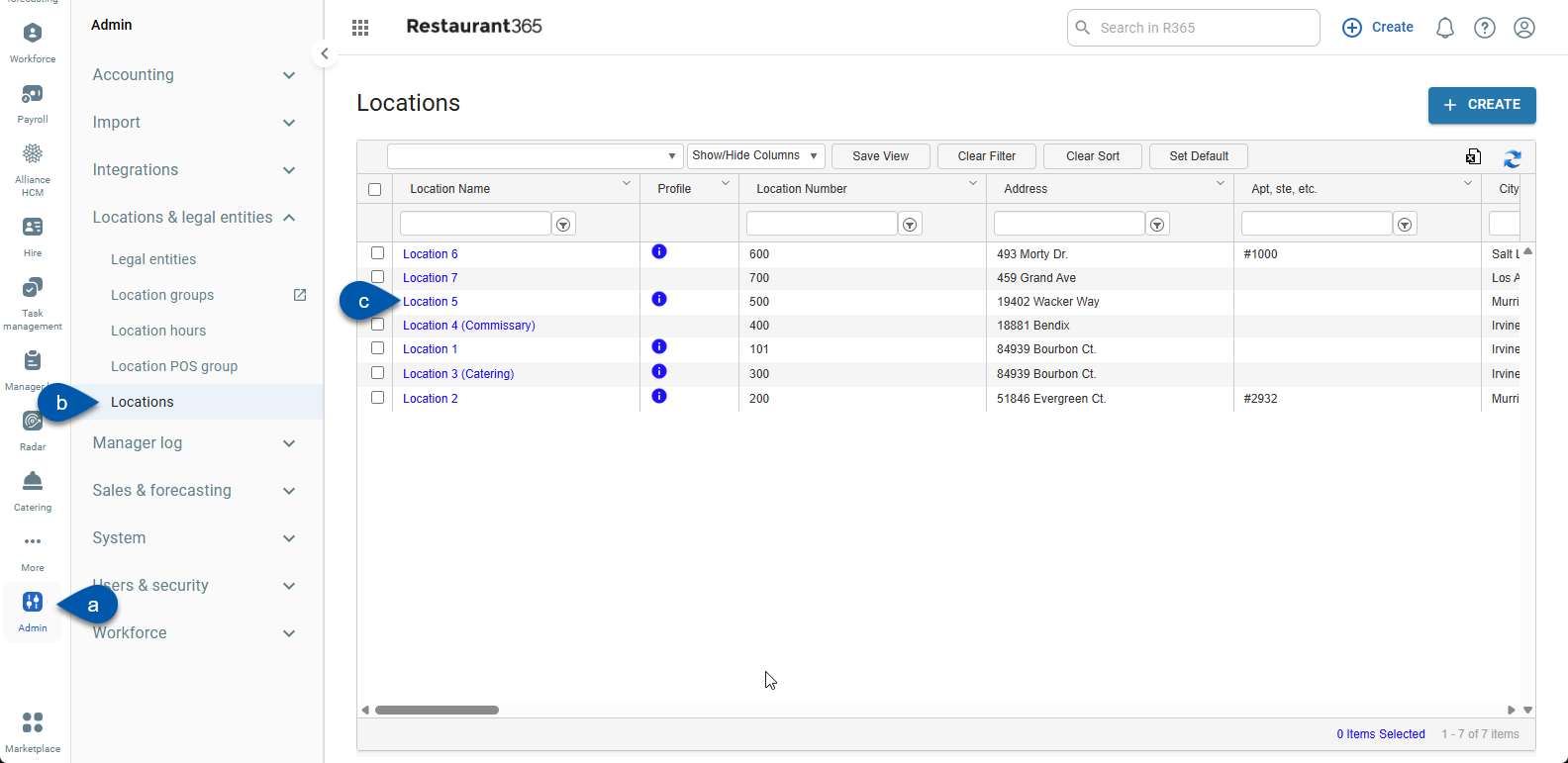Each location record includes core settings that define how data flows from the POS and posts to accounts in R365. These settings must be configured before the POS integration is installed or activated to ensure data imports and posts to the GL in R365.
These POS-related settings are found across four tabs, each focused on a distinct aspect of the location configuration:
General: Defines which data imports from the POS: Sales only or both Sales and Labor.
Default Accounts: Specifies the GL accounts used for checking, over/short, deposit, and credit expected transactions.
POS Integration Settings: Identifies the POS system and determines the import start date and time.
Labor Estimates: Defines required GL accounts for payroll, taxes, benefits, and other labor costs.
After completing the base setup, additional optional configurations are available. Learn more about optional POS integration settings on the location record.
Security
Users must have the following permission to edit location records:
Administration → Locations → Edit Locations
These permissions can be added to custom user roles or individual users. The Permission Access report can be used to determine which user roles or users already have these permissions assigned. For more information, see User Setup and Security.
Configure Location Settings Required For a POS Integration
Follow these steps to configure the location record settings required for a POS integration:
Click steps to expand for additional information and images.
1) Navigate to the desired location record.
a) Select Admin from the left navigation rail.
b) Under Locations and legal entities, select Locations.
c) Select the desired location.

General Tab
2) Set the POS Import type to either ‘Sales’ or ‘Sales and Labor’.
Sales - Defines that only sales data will be imported for the location. When selected, the POS Integration Settings tab becomes available.
Sales and Labor - Defines that both sales and labor data will be imported for the location. Required whenever labor data is included, whether it comes from the POS, a third-party time clock, or R365 Time Clock. When selected, the Labor Estimates and POS Integration Settings tabs become available.

Default Accounts Tab
3) Select the Default Accounts tab.

4) Select a GL account for each displayed account type.
These accounts must be assigned before the location record can be saved but have minimal impact on POS integration.
Checking Account: Select the default checking account for the location. If no accounts are available, confirm that the bank accounts on the GL are set up correctly. Learn more about bank account setup and bank records.
Deposit Account (Undeposited Funds): Select the default deposit account for the location. As a best practice in Restaurant365, use ‘Undeposited Funds’ rather than a checking account.
Over/Short Account: Select the default over/short account for the location.
Credit Expected Account: Select the default credit expected account for the location. This account tracks credits owed to the location.

POS Integration Settings Tab
5) Select the POS Integration Settings tab.

6) Select the POS system that the location uses.
Depending on the POS system, additional optional fields may appear. Learn more about optional POS integration settings.

7) Select the POS import start date.
The POS import start date determines when the integration tool begins importing Daily Sales Summary (DSS) data. Future imports will be limited to records dated on or after that date.
During implementation, R365 automatically imports up to 30 days of recent DSS data for testing and validation. When your organization reaches its go-live date, delete any test data and set the correct start date.

8) Set the POS import time.
The import time sets when POS data is brought into R365. It must occur after the POS end-of-day process to ensure the prior day’s sales are complete. As a best practice, schedule the import one to two hours after the POS end-of-day.
The POS import time is not the same as the R365 Start of Day, which defines the business day boundary. Both settings are tied to the POS end-of-day process. Learn more about how business days are defined in R365.

Labor Estimates Tab
When the POS import type is set to Sales and Labor, the Labor Estimates tab appears and includes one required setting: Accrued Payroll Account. This tab appears only when labor data is included in the POS import.
9) Select the Labor Estimates tab.

10) Select a GL account for the Accrued Payroll Account.
This setting defines the account that daily labor expenses post to and has minimal impact on POS integration. This account must be assigned before the location record can be saved.
Learn more about the optional labor estimate settings. 
Save and Next Steps
11) Click Save in the header to apply changes.

12) Connect the POS system.
The connection process varies by POS connection type: Local Install, Cloud Connection, or FTP. Each connection type follows a different set of setup steps.
Contact R365 Support for POS connection instructions.